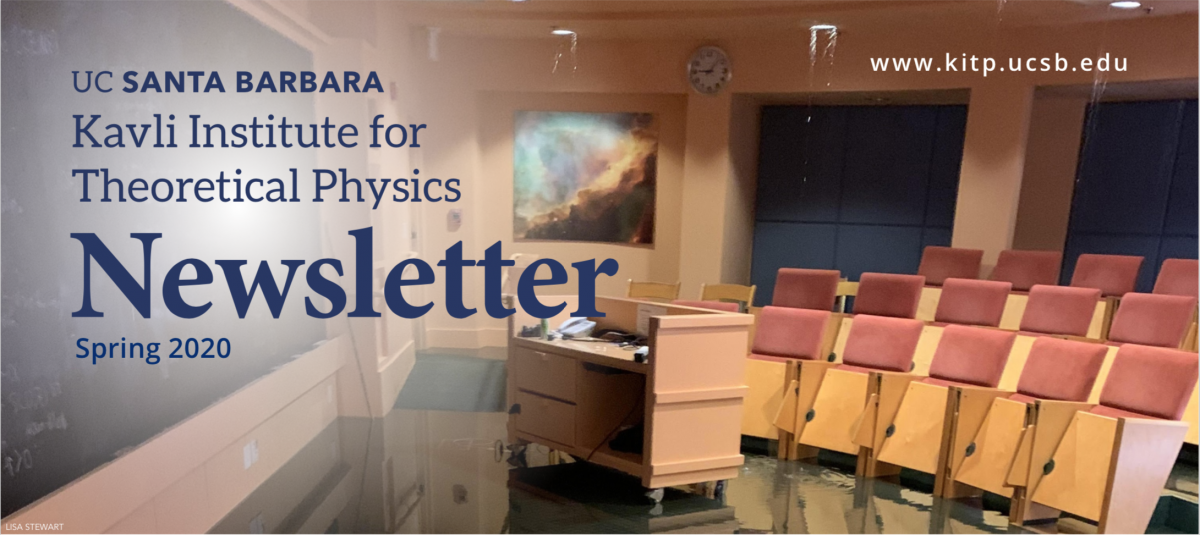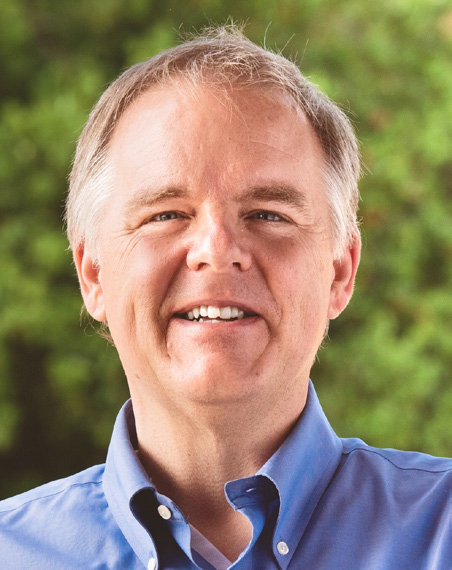
 Lars Bildsten.
Lars Bildsten.
Photo by Carter Hiyama.
On Sunday, March 8, 2020 I arrived at Kohn Hall at 9:30 AM to see water flowing out the door and down the steps! Unfortunately, Kohn Hall was experiencing a 10,000-gallon flood originating from the water heater on the second floor above the Auditorium (see image above). We lost the use of our Auditorium, Lobby and about 20 offices for our postdocs, graduate fellows, staff and visitors. Roughly 1/4 of Kohn Hall. This is an insured loss, so KITP’s burden is solely the stress, time and effort to reconstruct. KITP’s Chief Administrative Officer Lisa Stewart and I have been coordinating with the Campus and the many contractors to achieve the rebuild. We expect that reconstruction will be accomplished by late September. The silver lining is that we are adding new features (e.g. new cameras and microphones) that will enhance our in-person program activities through remote participation when we return to working in Kohn Hall.
As Covid-19 emerged in early March, we decided to continue to engage with our international physics community via “remote” interactions using the Zoom platform. We made the decision early enough so that nearly all of the participants for the “Symmetry, Thermodynamics and Topology in Active Matter” (ACTIVE20) and “Globular Clusters at the Nexus of Star and Galaxy Formation” (CLUSTERS20) programs could avoid traveling to Santa Barbara. Those few who were already on their way made the most of their prolonged stay with us, as you can see from reading the article they wrote here.
KITP’s Deputy Director Mark Bowick was one of the Coordinators for the ACTIVE20 program and was able to work closely with the other Coordinators Mike Cates (Cambridge), Nikta Fakhri (MIT), Cristina Marchetti (UCSB) and Sriram Ramaswamy (IISc Bangalore) to create something new for KITP: A fully remote program! This required remarkable planning, persistence and teamwork with our very able IT Staff of Alina Gutierrez (read about her here) and Craig Kunimoto to achieve nine weeks of nearly two-hour events almost every day.
All of the meetings were recorded and are now available online. This endeavor allowed KITP to continue our important mission of ensuring that collaborative science is always happening! Indeed, there is no better time than now for us to work even harder on that mission. The success of the ACTIVE20 program allowed for the CLUSTERS20 program to proceed in a similar manner. Each program brought nearly 100 people together at each event, allowing the participants to learn what others are working on and thereby define new intellectual streams. We will continue to support the explorations of the frontiers of science in this way, even during these difficult times. And, most importantly, all the lessons we have learned about the value of remote participation will stay with us, allowing for an expanded impact of KITP when in-person visits are again possible.
We have three science stories in this Newsletter that involve long-term participants at KITP. We highlight recent work by Professor Jørgen Christensen-Dalsgaard of Aarhus University, here. He is a frequent KITP visitor, starting decades ago in a program aimed at understanding how the Sun oscillates. This article highlights recent work done with his collaborators on just how stars further along in their evolution are ringing in a manner detectable by space-based telescopes. Brandeis Professor Bulbul Chakraborty’s long association with the KITP is described here, where you can read how the KITP has impacted the evolution of her research program. And lastly, for many years, KITP has been bringing biologists to the KITP for extended interactions. Harvard Professor Andrew Murray is a frequent guest and shares his views of the benefits of these deep engagements with physicists here.
We share a story about the Tower Room Lunch Series for women that was initiated in 2017 by Cornell Professor Eun-Ah Kim during her 2017 visit. These weekly gatherings are held in the iconic second-floor Castagnola-Hunter Tower Room at Kohn Hall, which was recently named in honor of KITP’s longtime friend and legacy donor Virginia Castagnola-Hunter. Her gift to the Postdoctoral Scholars Endowment Fund helps ensure support for early career scientists at KITP.
The last three months have been a very challenging time for the international physics community we serve, as well as all the KITP scientists and staff as we adjusted to working from home while still achieving our important mission. However, the shocking death of George Floyd has caused many of us here to reflect on what more KITP can do.
In closing, I quote from KITP’s Statement of Solidarity: “To pursue physics as both a passion and a vocation is truly a privilege and obliges us to root out racism in all its many forms.”
- Lars Bildsten, KITP Director
KITP Newsletter, Spring 2020
